 Iomega Part 2 - JAZ and Ditto
Iomega Part 2 - JAZ and Ditto
19th June 2021
If you have come to this page without reading Part 1, I recommend you start there as it covers Iomega's early days and the famous ZIP drive.
Jaz
With growing consumer demand in the multimedia market for larger-capacity and faster storage, Iomega got to work on a higher-end solution than ZIP - one that would essentially be a removable hard disk. Branded "Jaz", it first shipped 1 year after the launch of ZIP, and featured cartridges that could store up to 1 GB of data.
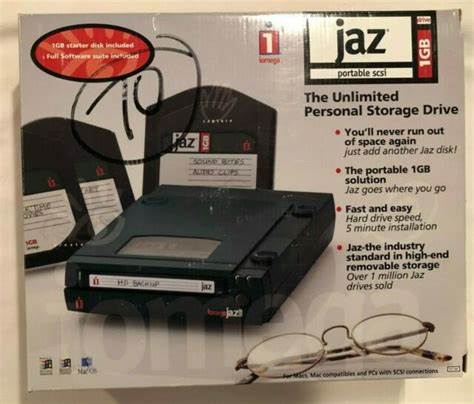
The original Jaz box (1995)
Unlike the ZIP, Jaz would connect to a computer only via SCSI (so you needed to also buy a SCSI controller such as Iomega's own Jaz Jet). Later variants of the Jaz drive would support USB and a parallel port, and they even produced a Firewire adapter you could purchase separately. The Jaz Jet SCSI Host Controller, to use its proper name, was just a rebranded Adaptec AHA-2930C SCSI Host Controller.
While Iomega Jaz initially sold as an external drive, they later released an internal drive suitable for installation in a 3.5" floppy drive bay just as they had done with the ZIP drive. This would still connect to a SCSI controller card via a 50-pin SCSI cable.
The cartridge [they're not disks!] appeared similar to a ZIP disk, but they actually used proper hard drive technology. At launch a 1 GB cartridge was competitively priced at around £100 GBP or $99 USD - that's 10c per MB.
Within the cartridge's case are three 3.5" solid platters on a spindle like a hard disk. Jaz cartridges for the PC came pre-formatted with a single FAT16 partition. Much like any hard disk, a Jaz cart could be repartitioned and reformatted.
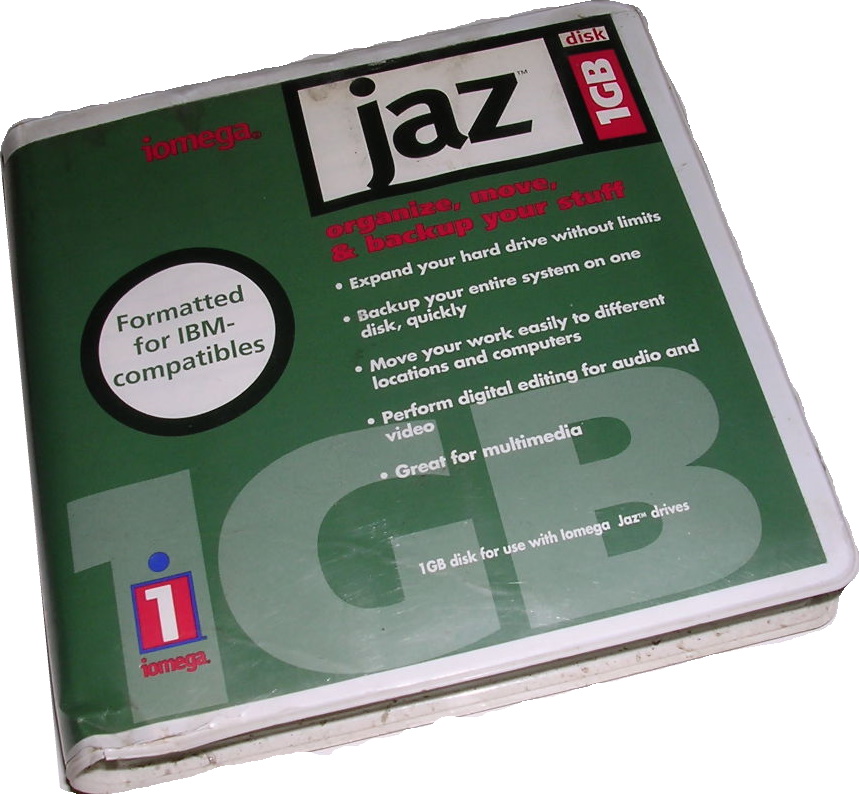

A Jaz cartridge and protective case (1995)
Cosmetically, the Jaz looked very similar to the earlier Zip, except Jaz was green instead of blue. One key difference is that because Jaz was really a hard disk it needed to be flat on the desk, not on its side like you could with a Zip drive.
Performance of the Jaz drive was slightly faster than hard disks at the time, offering a 12ms seek time and sustained data transfer rates of between 3.77 and 6.73 MB per second.
Issues
Jaz drives did suffer from more issues than a typical hard disk. This was largely caused by the fact that the storage medium itself was removable, and hence had a slider which was opened by the drive when the cart was inserted. Dust could sit on the surface of the slider and get in to the platter over time, causing data corruption (there's a good reason why hard disks are manufactured in clean rooms and are sealed units!).
Jaz 2 GB
In February 1998 Iomega launched the 2 GB Jaz drive. These could still take 1 GB cartridges, though the shape of the 2 GB cartridge was made slightly different to prevent inserting a 2 GB cart into a 1 GB drive.
About a year after its launch a brand new 2 GB Jaz cartridge would still retail for around $90 USD, so the cost per megabyte was not decreasing over time for Jaz.
As we have come to see, the rise in popularity of the rewriteable CD caused Jaz sales to drop, as the cost per megabyte was becoming so much cheaper with optical media - that, and the ubiquity of CD-ROM drives in all computers that could read your optical disc. Production of the Jaz drive ceased in 2002.
Ditto
The Ditto actually predates even the earliest ZIP drive. Launched in 1992, Ditto was Iomega's tape backup solution available only for the PC [not the Macintosh]. The cost of backing up your data with Ditto was apparently 1/10th that of using ZIP or Jaz. Because it was a tape drive, it stored data sequentially so was only good as a data backup solution - this differed from random access devices such as ZIP or Jaz (or traditional floppies and hard disks) where your computer could quickly locate a file at any point on a disk and load it immediately.
Initially available as the Ditto Easy 800, these could store up to 800 MB per cassette, though using compression the real-world capacity was larger. Iomega assumed 2:1 data compression ratio in its ratings for Ditto drives - the actual compression achieved was dependent on the type of data being backed up.
The Ditto Easy 800 was soon followed by the Ditto 2GB (2 GB per cassette), and the Easy Ditto 3200 (3.2 GB per cassette). Marketing for cassettes tended to display the largest possible amount of storage after compression:
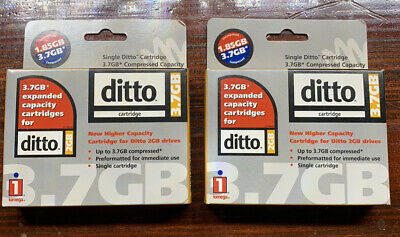
3.7 GB compressed, or 1.85 GB uncompressed
If you had an internal Ditto drive it connected to your PC via a standard floppy drive interface. External Ditto drives would connect via the parallel port - these permitted data transfer speeds of up to 1 MB per second, compared to more like 85 - 154 KB per second over a floppy interface. The internal Ditto Easy 3200 came with an 'accelerator' card called Ditto Dash which could increase data throughput on 500 KB/sec controller cards. The card could also be used with the Ditto Easy 800 to improve performance of that drive too.
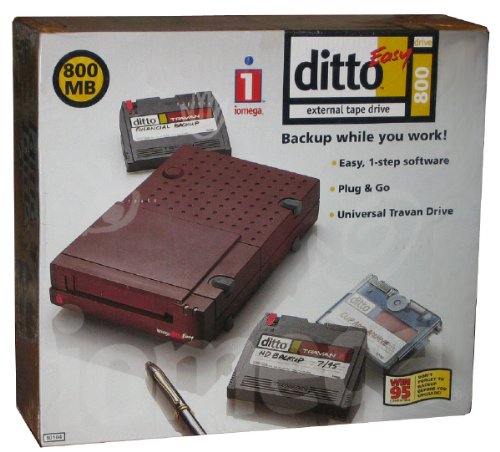
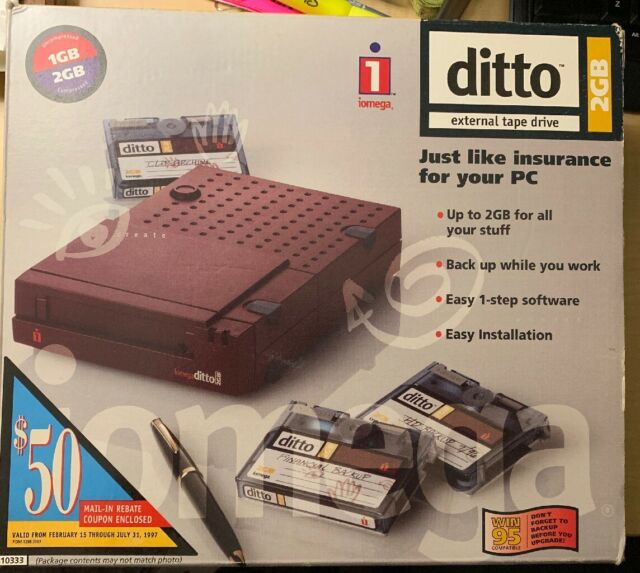
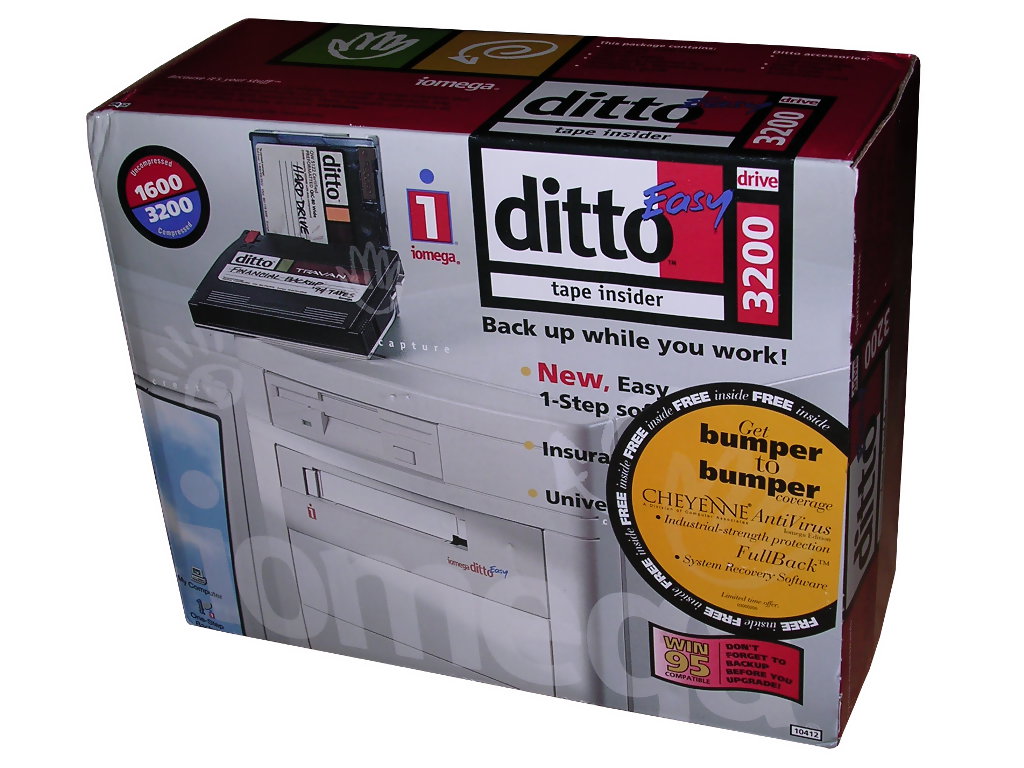
From left: Ditto Easy 800, Ditto 2GB, and Easy 3200 (1996)
The cassettes themselves came in a variety of physical cartridges, initially following the already-popular QIC (Quarter-Inch Cartridge) standard introduced by 3M back in 1972, but later Iomega designed their own to support larger capacities. Some tapes were a quarter of an inch wide (6.35mm), but the later ones (Ditto Max and Ditto Max Pro) used 8mm wide tape.
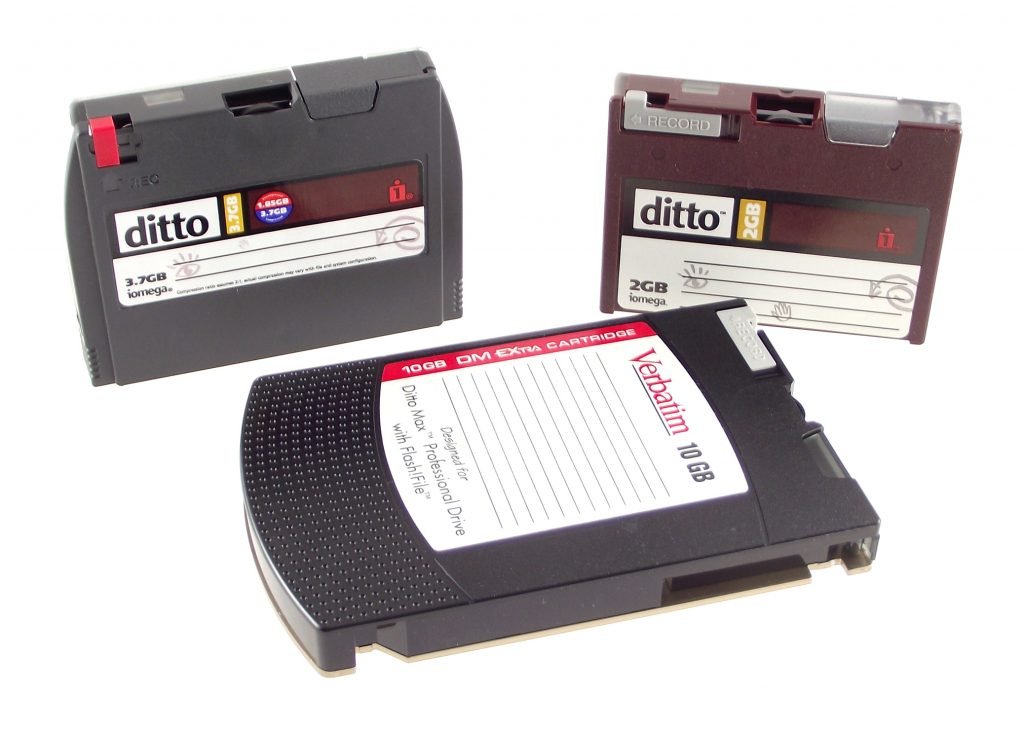
Different physical tape cartridge (cassette) standards used by Ditto drives.
Clockwise from top-left: Travan (superceded the QIC Mini-Cartridge), a QIC-Wide cartridge, and a QIC-EXtra cartridge.
The final version of Ditto, the Ditto Max Pro, was released in 1998 and offered compressed storage of 3 GB, 3.7 GB, 5 GB, 7 GB and 10 GB on a single magnetic cassette. The last Ditto drives were manufactured in 1999, when production of the entire line of Ditto products ceased.
Head over to Part 3, where I cover the Clik!